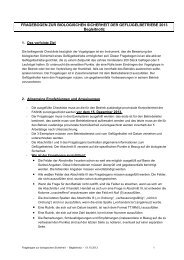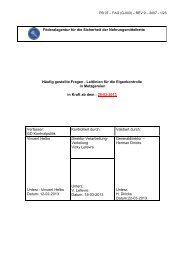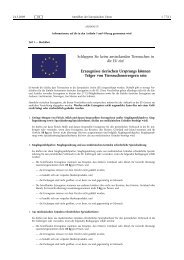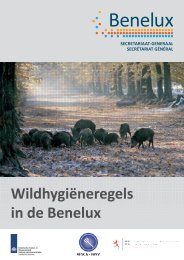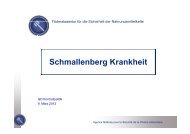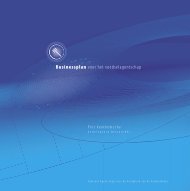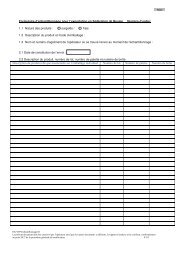Bijlage 2 Synthesetabel - Favv
Bijlage 2 Synthesetabel - Favv
Bijlage 2 Synthesetabel - Favv
Create successful ePaper yourself
Turn your PDF publications into a flip-book with our unique Google optimized e-Paper software.
1.7. Heterocyclische<br />
aromatische amines<br />
-3 (g)<br />
2A, 2B x x 0,56-118 x 10<br />
PhIP 2B 0,74 (16)<br />
4,8-7,6 x 10 -3 Gemiddelde blootstelling<br />
(g)<br />
(hypothetisch<br />
restrisico voor kanker<br />
= 10 -4 -10 -3 )<br />
170.000-260.000<br />
(USA) (16)<br />
1.8. Nitro-PAK 2B, 3 x x Blootstelling is<br />
verwaarloosbaar t.o.v.<br />
PAK (8)<br />
1.11. Semicarbazide x (in vitro) 0,02 Volwassenen (10)<br />
0,35-1,4 Zuigelingen (10)<br />
Min. 5 ordes van<br />
grootte tussen dosis<br />
die tumoren<br />
veroorzaakt bij<br />
proefdieren en de<br />
blootstelling van de<br />
mens (incl. baby’s). (10)<br />
(*) Rangschikking van de contaminanten binnen de verschillende prioriteitsklassen is alfabetisch<br />
(a) MOE berekend op basis van de in de tabel weergegeven P50/P97,5 blootstelling en het vermelde punt op de dosis-responscurve (d/r), i.e. BMDL, maar kan ook T25,<br />
NOAEL etc. zijn<br />
(b) respectievelijk gemiddelde blootstelling en blootstelling voor grote consumenten<br />
(c) respectievelijk max. gemiddelde en P95 innameschatting wanneer [3-MCPD] in sojasaus 0,02 mg/kg verondersteld wordt<br />
(d) gemiddelde inname (voeding) en hoge inname (voeding + alcoholische dranken)<br />
(e) ruwe schatting van de gemiddelde blootstelling<br />
(f) gemiddelde en P95 blootstelling (“P95” inname voor baby’s betreft baby’s van 6-9 maanden op basis van enerzijds de P95 consumptie voor potjes babyvoeding en de<br />
gemiddelde consumptie van zuigelingenvoeding en anderzijds de gemiddelde consumptie van potjes babyvoeding en de P95 van zuigelingenvoeding)<br />
(g) op basis van gegevens in tabel 1.5.2. van fiche 1.5., in de veronderstelling van 71 kg lichaamsgewicht<br />
(i) op basis van gegevens in tabel 1.9.1. van fiche 1.9., in de veronderstelling van 71 kg lichaamsgewicht<br />
(j) mediane / P97,5 inname van PAK2 = BaP, chryseen; PAK4 = PAK2 + benz[a]anthraceen, benzo[b]fluorantheen; PAK8 = PAK4 + benzo[k]fluorantheen, benzo[ghi]peryleen,<br />
dibenz[a, h]antraceen en indeno[1,2,3-cd]pyreen<br />
(k) worstcase blootstelling<br />
(1) Zie advies<br />
(2) Sci Com Advies 25-2008: Acrylamide: blootstelling van de Belgische bevolking, bijdrage van verschillende levensmiddelen en methodologie voor het vastleggen van<br />
actielimieten (dossier Sci Com 2007/37) http://www.favv-afsca.fgov.be/wetenschappelijkcomite/adviezen/2008.asp<br />
(3) European Commission Directorate-General Health and Consumer Protection, Report of experts participating in Scientific Cooperation task 3.2.9 . “Collection and<br />
collation of data on levels of 3-monochloropropandiol (3-MCPD) and related substances in foodstuffs”, June 2004.<br />
http://ec.europa.eu/food/food/chemicalsafety/contaminants/mcpd_en.htm<br />
(4) JECFA (2006) Summary and conclusions of the sixty-fourth meeting of the joint FAO/WHO Expert Committee on Food Additives (7 July 2006). Rome, 20-29 June<br />
2006. http://www.who.int/ipcs/food/jecfa/summaries/summary67.pdf
(5) JECFA (2005) Summary and conclusions of the sixty-fourth meeting of the joint FAO/WHO Expert Committee on Food Additives. Rome, 8-17 February 2005.<br />
http://www.who.int/ipcs/food/jecfa/summaries/summary_report_64_final.pdf<br />
(6) Claeys W., Vleminckx C., Dubois A., Huyghebaert A., Höfte M., Daenens P. & Schiffers B. (2009) Formaldehyde in cultivated mushrooms: a negligible risk for the<br />
consumer. Food Additives & Contaminants 26(9), 1265-1272.<br />
(7) EFSA (2009) Results on the monitoring of furan levels in food. A report of the Data Collection and Exposure Unit in response to a request from the European<br />
Commission. (Question No EFSA-Q-2009-00607) http://www.efsa.europa.eu/EFSA/efsa_locale-1178620753812_1211902588085.htm<br />
(8) WHO (2003) Selected nitro- and nitro-oxy-polycyclic aromatic hydrocarbons. http://www.inchem.org/documents/ehc/ehc/ehc229.htm<br />
(9) EFSA (2008a) Polycyclic aromatic hydrocarbons in food. Scientific opinion of the Panel on Contaminants in the Food Chain. (Question No EFSA-Q-2007-136)<br />
http://www.efsa.europa.eu/EFSA/efsa_locale-1178620753812_1211902034842.htm<br />
(10) EFSA (2005) Opinion of the Scientific Panel on Food Additives, Flavourings, Processing Aids and Materials in Contact with Food on a request from the Commission<br />
related to Semicarbazide in food. (Question number EFSA-2003-235) The EFSA Journal 219, 1-36.<br />
http://www.efsa.europa.eu/EFSA/Scientific_Opinion/afc_op_ej219_semicarbazide_en2.pdf<br />
(11) Hwang M., Yoon E., Kim J., Jang D. & Yoo T. (2009) Toxicity value for 3-monochloropropane-1,2-diol using a benchmark dose methodology. Regulatory Toxicology<br />
and Pharmacology 53, 102–106.<br />
(12) JECFA (2005) Summary and conclusions of the sixty-fourth meeting of the joint FAO/WHO. Expert Committee on Food Additives. Rome, 8-17 February 2005.<br />
http://www.who.int/ipcs/food/jecfa/summaries/summary_report_64_final.pdf<br />
(13) Health Canada (2006) Health Risk assessment – Benzene in beverages. http://www.hc-sc.gc.ca/fn-an/securit/chem-chim/food-aliment/benzene/benzene_hra-erseng.php<br />
(14) U.S. EPA (2003) United States Environmental Protection Agency. Integrated Risk Information System (IRIS) - Benzene (CASRN 71-43-2).<br />
http://www.epa.gov/iris/subst/0276.htm<br />
(15) Carthew P., DiNovi M. & Setzer W. (2010) Aplication of the margin of exposure (MoE) approach to substances in food that are genotoxic and carcinogenic. Example:<br />
Furan (CAS No. 110-00-9). Food and Chemical Toxicology 48, S69-S74.<br />
(16) O’Brien, J., Renwick, A., Constable, A., Dybing, E., Müller, D., Schlatter, J., Slob, W., Tueting, W., van Benthem, J., Wiliams, G. & Wolfreys, A. (2006) Approaches to<br />
the risk assessment of genotoxic carcinogens in food: a critical appraisal. Food and Chemical Toxicology 44, 1613-1635.


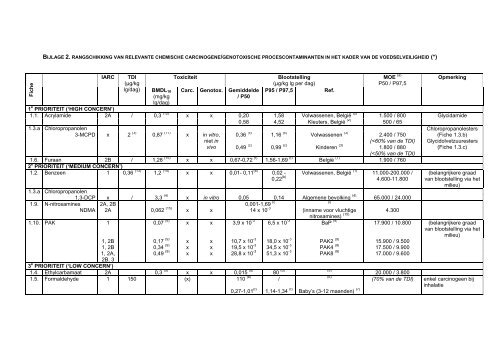
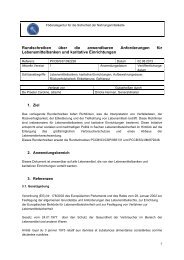
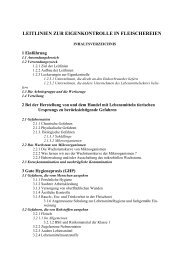

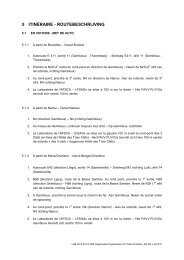
![DPA 2298 Schweine: Aujeszky-Impfung [2298] v2 - FAVV](https://img.yumpu.com/22032815/1/184x260/dpa-2298-schweine-aujeszky-impfung-2298-v2-favv.jpg?quality=85)
